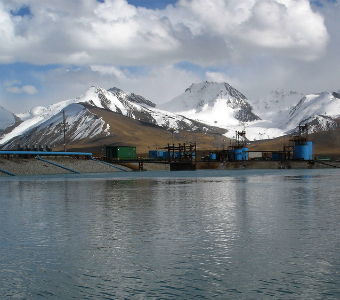Мы неоднократно писали о руднике Кумтор в данном блоге, поэтому ниже представлена лишь краткая сводка основных фактов по недавним событиям:
- В докладе межведомственной комиссии, в состав которой входили представители государственной власти и НПО, приведены доказательства того, что работы по добыче золота канадской корпорацией Centerra Gold несут угрозу местной окружающей среде, в частности, качеству водных источников и ледников. Среди прочих мер, даже рекомендуется временно приостановить ведение работ на месторождении.
- К докладу прилагался еще один отчет, подготовленный доктором Робертом Мораном (pdf) и опубликованный сетью организаций «Бенквоч». В нем описаны доказательства того, деятельность компании привела к загрязнению местных водных ресурсов и ледников, при том, что эти факты утаиваются от общественности. (Доктор Моран входил в состав межведомственной комиссии, однако в итоге ему не дали разрешения на посещение рудника. Это не изменило его намерений и он провел самостоятельное полевое исследование в сопровождении меня и оператора. Сопутствующее видео.)
Уже на прошлой неделе мы получили некоторые результаты своей работы. Поскольку у межправительственной комиссии был правительственный статус, подготовленный ею доклад и рекомендации обсуждались на правительственном заседании и парламентских слушаниях.
В ходе проведения правительственного заседания заместитель премьер-министра Аалы Карашек не только подтвердил изложенные в докладе факты, но и отдал распоряжение о принятии конкретных мер (с определением сроков их реализации) с целью дальнейшей оценки и устранения негативных последствий работ на руднике Кумтор (подробнее на сайте правительства Киргизстана.
Члены парламента приняли решение учредить еще одну комиссию для оценки прочих (в том числе экономических) аспектов деятельности компании Centerra, которые не были освещены в данных двух докладах.
Это прекрасные новости. Мы рады, что наша работа за последний год не была напрасной. Особенно учитывая тот факт, что получение подробной, комплексной и обоснованной информации по месторождению Кумтор и последствий ведения работ на нем для местного населения было крайне затруднительным, поскольку компания «контролирует рудник как собственную вотчину, предоставляя доступ на его территорию лишь ограниченному числу лиц».
Экологи и местные жители уже долгое время взывали к власти. Теперь, наконец, о проблеме в полный голос заговорили эксперты и представители правительства Киргизстана. Однако во всем этом паззле еще не хватает одного элемента – Европейского банка реконструкции и развития (ЕБРР), который слишком долго верил заявлениям Centerra Gold и в 2010 году утвердил выдачу очередного кредита возможно на цели разработки Кумтора.
Мы надеемся, что ЕБРР следит за развитием этих событий в Киргизстане и примет соответствующие меры. ЕБРР стоит на данном примере усвоить некоторые уроки и отобразить это в своей новой Стратегии в горнодобывающей отрасли. В прошлом году мы уже предлагали пункты для включения в стратегию, в том числе – формирование запретных зон для ведения горнодобывающих работ. К ним должны относиться и ледники.
Кумтор является примером того, как добывающие работы могут привести к загрязнению местных водных ресурсов. Кроме того, рудниковая пыль и практика складирования отвальной породы на ледниках привела к ускоренному таянию ледников (такие темпы таяния не предусматривались прогнозами компании Centerra и ЕБРР).
Если закрывать глаза на эти риски, это приведет лишь к повышению угрозы, которую несет изменение климата – как на месторождении Кумтор, так и в других местах в мире. ЕБРР не должен ставить коммерческие интересы выше экологических соображений.
Never miss an update
We expose the risks of international public finance and bring critical updates from the ground – straight to your inbox.
Institution: EBRD
Theme: Social & economic impacts | Other harmful projects | Mining
Location: Kyrgyzstan
Project: Золотоносный рудник Кумтор, Киргизстан
Tags: local impacts | policy | pollution

